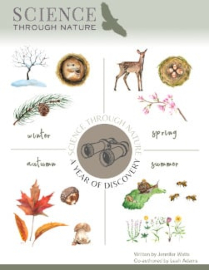A Year of Discovery offers a secular approach to nature study for children in the elementary grades that includes field experience, stories, and information. This 116-page PDF has lessons for 12 months, beginning with January, although you can begin with any month.
The same authors have written Be a Naturalist. A Year of Discovery is lighter academically and might make the best starting place, especially for children in first grade. Be a Naturalist is still activity-oriented and fun, but it requires more written work and is best used with children in grades two through five. You also might consider using A Year of Discovery alongside Be a Naturalist to focus on seasonal changes.
In A Year of Discovery, each month’s study, called a “Nature Quest,” features seasonal topics and activities to support learning through nature walks, investigations, observations, experiments, books, videos, and hands-on activities. A Year of Discovery should work best for those who live in areas with definite seasons and have access to natural settings. Those who live in areas with less noticeable seasonal changes might have to skip parts of lessons. Also, some activities are dependent upon a certain type of wildlife, such as fireflies, that might not be found in your area. Those living in heavily urban areas can use parks or other publicly accessible places where they can access nature, but it might be more challenging.
The introductory material explains how the course works, lists recommended resources (books, websites, apps, and podcasts) for the entire study, lists children’s literature to accompany each Nature Quest, and provides the page numbers in the Handbook of Nature Study 1st edition by Anna Botsford Comstock (in the common domain), which the authors recommend parents read.
Parents need to plan in advance and gather resources, including nature guides, which you should be able to borrow from your library. You shouldn’t need to print anything from A Year of Discovery.
Students will create their own journals and nature collections as they work through the study. Instructions for both are in the introduction.
Sample Nature Quest
I’ll use parts of the September Nature Quest to give you an idea of how it works. A very brief introduction lists five “missions” or objectives. I’ll describe the first two missions.
The first mission, “Study Sensational Sunflowers,” has children study an actual sunflower in detail, then it provides questions for parents to guide children, such as “How does the stem feel?” Next, students try to sprout sunflower seeds. In their journals, they will sketch the sunflower; guess the number of florets or seeds (then make an actual count if possible); measure the sunflower, its stem, and the length of its leaves; and mount samples of the petals and either florets or seeds. Following that, parents read aloud Camille and the Sunflowers by Laurence Anholt, a story about Vincent van Gogh and his sunflower paintings, and students try painting their own sunflowers. Lastly, students watch an online video that explains “Why Sunflowers Follow the Sun.” As you probably noticed, the first mission will clearly take more than a day, and some activities, such as sprouting seeds, will probably overlap the next mission or two.
The second mission, “Observe Busy Grasshoppers,” requires students to catch a grasshopper for observation and try to determine its species. Next, children can use three links to watch online videos that show grasshoppers jumping in slow motion, “making music,” and laying eggs. Parents can read aloud the information in the guide about grasshoppers, as well as the poem “September” by Helen Hunt. If goldenrods (mentioned in the poem) grow in the area, students should examine them closely. Then students can write their own September poems.
A Year of Discovery has embedded links throughout to videos, crafts, nature cams, and other educational resources.
Each month’s Nature Quest shows a simple chart and tells students to draw one like it in their adventure journal. On the same day each week, they record on the chart the date, the high temperature, the time of sunrise, and the time of sunset. At the end of the year, they are to graph all this information to see how it changes. Students also create an ongoing “Colors of Nature” project, a sort of color wheel on a large poster board where students mount flower petals, seeds, leaves, and other objects they collect to represent the colors of each season. These overarching activities help students understand the cyclical nature of seasons.
Overall, very little written work is required of students, and that makes A Year of Discovery usable with a broad age range. It’s also very adaptable. You can select age-appropriate books from the recommended reading lists for each month. In addition, younger students might not participate as fully as older students. For example, you might require more detailed observations and sketches from older students than from younger.
Summary
A Year of Discovery should be a delightful resource for parents who want to do nature study but need guidance and inspiration.









